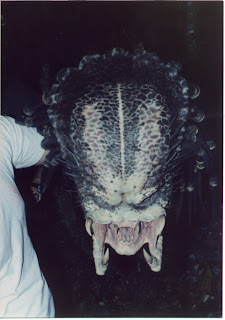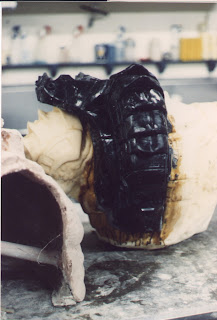What the HELL had I done? I loved working at Stan's and although at that moment the pressure was on, through my actions I had made "bad" - "WORSE!" I think a little squeak must have escaped my clenched esophagus because what happened next was an act of friendship that I will never forget -
Without hesitation, Steve Wang mixed up some bondo, spatulated into the door and SCULPTED THE WOOD GRAIN PATTERN into the patch and when it set, Matt Rose MATCHED THE DOOR COLORS and painted the patch so it was imperceptible. They didn't make a big deal out of it, they just did it. At that moment - due to those actions - I knew we would be not just a team, but the kind of team that really had each other's backs. They say brothers are made on battlefields, the same can be said of people that unite on a film project when it appears the odds are against them. Steve and Matt are my "brothers" for life.
The Predator suits were coming together. Pieces were hastily seamed, painted and coated with BJB SC-89 to enhance the colors and protect the paint jobs.
Leslie Neumann appeared one day with the red-suit pieces and had made an extra body cover and gloves should something go wrong. She told me that she didn't know what to do with the backpack strapping so we would just have to tie it on with a piece of red spandex. It was a fantastic job and I was happy to get her some work while scratching something off of the list of things to do. I packed it into a cardboard box and put it with a growing stack of things that were to be sent via truck into Mexico.
 |
| Alright Matt Rose! It looks fantastic! Get it into a BOX! |
 |
| Propmaker extrordinaire, Brent Scrivener, built the medical pack - It could actually be filmed being removed from the backpack, but ultimately was only seen in this insert shot. |
Wrong. This is 1987 (specifically January) and glow sticks are not just difficult to get just ANYWHERE but they only come in GREEN! After numerous phone calls back and forth to distributors, manufacturers, Joel Hynek in New York, Joel Silver in Los Angeles, the blood would HAVE to glow green. It would just HAVE to....After much brow-beating, Joel Hynek aquiesced and said that his team would rotoscope all of the orange shots, green - he wasn't happy about it. In hindsight, I wonder if he charged Joel Silver for overages? Hmmmmmm...
Then, there was another issue: We were going to be in Mexico - specifically Palenque, Mexico which was close to the Yucatan Penninsula. It was warm in Los Angeles, but it was going to be very hot in Mexico. Kevin Peter Hall was concerned about being in a thick, foam rubber insulated suit and suggested (?), insisted (?) that we get him a "cool suit." Remember, this was 1987; who the hell knew what a cool suit was?
Enter Chris Gillman of the Dilligent Dwarves prop building company (check out his blog here: Diligent Dwarves. He was friends with Kevin and had developed a mesh vest that had a serpentine pattern of vinyl tubes running through it. The tubes connected to a reservoir that held chilled water and spiralling through that reservoir was a coil of metal tubing that attached to quick disconnect fittings on either end. Propylene Glycol was pumped through the tubing essentially wicking off Kevin's body heat via the liquid and cooling it in the chamber and transferring cool water back to him. It was very ingenious. There was only one draw back - the unit was fairly large (about a 2 foot square) and a bit heavy (I think the unit weighed about 25 pounds or so). If we were going to be in a soundstage somewhere, I didn't think it would be an issue, but having Steve, Matt, Shane, Richard or I lugging this damn thing around seemed, let us say, unattractive.
What I needed was brute strength and a great attitude! Someone who would lug this machine around the steamy Palenque jungle, stepping over vines and snakes with a smile on his face. But where? Where? OH YEAH, BRIAN SIMPSON!
Steve and I made our case for the inclusion of Brian on the crew and Stan agreed and that's how a runner (technically) was brought to a film location and turned out to be a very, very valuable asset on such an iconic show. So the Predator on-set team was assembled.
So now the questions started: When do we leave? Where are we staying? What is the location like? Will there be water to drink? All good questions and someone had to ask them. That someone was me. I called the production office in Los Angeles and spoke with the production coordinator, parroting many of the questions my colleagues had and asking a few of my own. She told me this: a.) We were going to the jungle. THE jungle. It is hot, full of bugs and snakes, and was a treacherous area to be in. Her suggestion, clothing wise, was to go to a surplus store and buy "rip-stop" pants, leather boots that went up to the ankle (in case a snake decided to bite), and fatigue shirts, hats, etc. I pretended to know what "rip stop" was, took down all of the necessary information and disseminated it to the crew.
Oh yeah, and we all need Passports. PASSPORTS?! This is when I learned that Hollywood can move mountains if it needs to. None of us had passports AND we needed work visas for Mexico. I had never been out of the country. Richard and Shane were good because they had been in England for ALIENS and still had their passports. I called the passport office on behalf of the crew to make appointments and was told that we could get them in THREE WEEKS! We didn't have three weeks. I made a call to the production office and was told that all of us going to Mexico without passports had to drive down the to Federal Building in West Los Angeles the next day to get our credentials.
The first stop was a photo booth where we had to get pictures not only for our passports but for our work visas. Then, off to the Federal Building with our birth certificates (Thank God I had mine....I needed it to get married!). Within hours all of us had our new Passports. Three weeks.....THREE WEEKS?! This is Hollywood, baby! We need 'em in three minutes!
About four or five days before we were due to leave, a big production truck showed up for us to pack. It had been outfitted per our request with a work bench and some racks and things to hold the suits up. It was to be our "home away from home" for the next couple of weeks. We packed everything and then packed everything else we could think of (including clay and plaster should we need to sculpt and mold things on location) that would get us through what was promised to be a very challenging shoot (you can see a shot of the truck behind the photo of Kevin and Stan in part 1)
With everything packed and gone, there was nothing else to do but clean the shop up for the other Lifers (specifically, John, Alec, and Tom) who had begun pre-pre-prep on PUMPKINHEAD. We'll talk more about this later, but during the last few weeks of finishing the PREDATOR work, they had moved into the design room and had begun doing concept illustrations for Stan and the titular character. Much of our crew was laid off, but not before we assembled everyone for a crew photo in the front parking lot:
 | |
| Yes, it was this image that inspired the purchase of "My Lucky Hat" |
 |
| See what I mean? When you see pictures of Stan wearing this hat, just know...it's MINE dammit! |
Silly me.
We met at the Los Angeles, International Airport early one morning in February 1987. We had our tickets, our passports, and our LUGGAGE. Matt Rose had packed a HUGE footlocker full of food and water, determined not to get sick or poisoned during our journey. Sheesh! Then he tells me that he's deathly afraid of flying. I thought he was kidding. He was not. He excused himself, went to an airport bar and got himself a drink to steady his nerves.
On the plane, it became very apparent that Kevin was the "performer" and we were "the crew". We got on the plane and he sat in First Class and the rest of us made our way back to coach. Okay, so there WAS more leg room for Kevin, but then again, he was Screen Actor's Guild and according to the standard contract he HAD to fly first class. Little did I know that I would have MANY opportunities to enjoy the spoils of SAG later in my career.
We landed in Mexico City (our first port of call on our way to Palenque) where we met our "contact" set up for us by production. I couldn't tell you his full name, but he introduced himself as "Harry" so he became "Airport Harry." Although a Mexican citizen, he not only spoke English VERY well, but was, if you pardon the expression, slicker than goose-sh*t. Harry met us at the gate, got us through immigration/customs, and then took us to the next gate (all of this was pre-911, when you could actually go to the gates without a boarding pass, but I digress). We shared a beer with Harry and he taught us some rude gestures and gave us some pointers like "Don't take ice that doesn't have a hole through the center of it, because that means it wasn't made with safe drinking water" (something to do with the freezing process), etc.
Our next flight took us to a small airport in Villa Hermosa. We were met by a Mexican driver from production in a Volkswagen Van, the kind that are associated with hippies - the van, not the driver, and off we went to Palenque, and ADVENTURE!
















